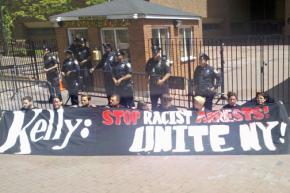NYC protests for the mothers
reports on Mother's Day protests against police violence in New York.
NEW YORK City saw three demonstrations over Mother's Day weekend to highlight the pain that mothers endure when the NYPD brutalizes and murders their children.
On May 10, Constance Malcolm and Franclot Graham, parents of 18-year-old Ramarley Graham, who was shot and killed by officer Richard Haste in the bathroom of his Bronx home more than three months ago, hosted a pre-Mother's Day vigil in their home.
The family has been hosting vigils every Thursday since Graham's death on February 2. Other mothers who have lost their children at the hands of police officers were invited to come and speak.
About 100 friends, neighbors, community members and activists gathered around the front porch of the family's home to hear Valerie Bell, mother of 23-year-old Sean Bell, killed by police on November 25, 2006; Allene Person, mother of 19-year-old Timur Person, killed by police on December 13, 2006; Danette Chavis, mother of 19-year-old Gregory Chavis, killed by police on October 9, 2004; and Juanita Young, mother of 23-year-old Malcolm Ferguson, killed by police on March 1, 2000.

All lent their unwavering support to Malcolm--Juanita Young pointed out that the gathering proved "these are not isolated incidents."
Young also told the gut-wrenching story of how police initially lied to her, telling her they found her son dead in the hallway of her building. "No you didn't," she said. "You killed him. Officer Louis Rivera killed my son. Why? I still don't know, and I'm still trying to get murder charges against Officer Rivera."
During an angry march to the 47th Precinct led by Graham's parents, the air was filled with chants of "Whose streets? Ramarley's streets!" and "No justice, no peace! No racist police!" Graham's parents stood facing the precinct--and the line of police guarding the entrance--with the crowd behind them chanting, "Justice for Ramarley! Jail the guilty cops!"
Musical performances by Ramarley's friend, singer/songwriter Rally Bop, and other artists honored Ramarley's memory, and demonstrators vowed to keep fighting.
On May 12, some 150 people turned out for a protest called "A Tale of Two Cities: March and Rally to End Illegal Arrests and Biased Police Practices," aimed at highlighting the massive racial disparity of those arrested for marijuana possession in New York City.
New York state decriminalized possession of 25 grams of marijuana or less in 1977, as long as it is not in public view. Most people actually arrested had only a small amount in their pockets, but were coerced into making this in public view through NYPD stop-and-frisk practices. More than 50,000 New Yorkers were arrested last year for marijuana possession.
Although most drug users are white, 87 percent of the people arrested for marijuana possession are Black and Latino.
Called by a coalition headed by VOCAL-NY, the Drug Policy Alliance and the Institute for Juvenile Justice Reform and Alternatives, protesters marched on One Police Plaza with a massive banner calling for Police Commissioner Ray Kelly to stop racist arrests in New York City.
Rally speakers included activists from Stop Stop and Frisk and numerous other groups, as well as elected officials who have introduced state and city legislation that would decriminalize all marijuana possession, including when it is "in plain sight," and that would require police to inform those detained that they have the right to refuse being searched.
Finally, on May 13, about 50 activists and community members marched through the streets of the South Bronx for an event called "A Mother's Outrage" organized by Mothers Resist Racist Policing. Marchers chanted "Money for jobs and education! Not for mass incarceration!" and "NYPD KKK! How many kids did you kill today?"


